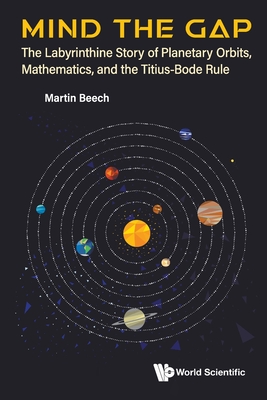Mind the Gap: The Labyrinthine Story of Planetary Orbits, Mathematics, and the Titius-Bode Rule

Mind the Gap: The Labyrinthine Story of Planetary Orbits, Mathematics, and the Titius-Bode Rule
The story presented will look at how humanity has learned about the workings of the solar system, and it will look at the philosophical problems that arise when mathematical exposition leads observation. Furthermore, the fundamental role of mathematics in the development of physical theory is examined, and it is argued that there are some gaps in our knowledge of the solar system (and the universe) that mathematics and physical theory will never successfully bridge. The text will present material at the informed-amateur scientist, university undergraduate student level.
This book is concerned with two tightly knit topics -- those of mathematics and astronomy. Its focus is primarily concerned with planetary astronomy, and specifically the history of accounting for the spacing of planetary orbits. The story begins with the ancient Greek philosophers and continues to the modern era and the new data being gleaned from the study of exoplanetary systems. Throughout the text, the manner in which mathematical theory has been used to decipher, and impose order upon the solar system, will be examined. Attention and discussion will be directed towards the so-called Titius-Bode rule, a long-standing ordering principle, that in fact it has no physical underpinning or explanation.The story presented will look at how humanity has learned about the workings of the solar system, and it will look at the philosophical problems that arise when mathematical exposition leads observation. Furthermore, the fundamental role of mathematics in the development of physical theory is examined, and it is argued that there are some gaps in our knowledge of the solar system (and the universe) that mathematics and physical theory will never successfully bridge. The text will present ma
PRP: 446.40 Lei
Acesta este Pretul Recomandat de Producator. Pretul de vanzare al produsului este afisat mai jos.
401.76Lei
401.76Lei
446.40 LeiIndisponibil
Descrierea produsului
The story presented will look at how humanity has learned about the workings of the solar system, and it will look at the philosophical problems that arise when mathematical exposition leads observation. Furthermore, the fundamental role of mathematics in the development of physical theory is examined, and it is argued that there are some gaps in our knowledge of the solar system (and the universe) that mathematics and physical theory will never successfully bridge. The text will present material at the informed-amateur scientist, university undergraduate student level.
This book is concerned with two tightly knit topics -- those of mathematics and astronomy. Its focus is primarily concerned with planetary astronomy, and specifically the history of accounting for the spacing of planetary orbits. The story begins with the ancient Greek philosophers and continues to the modern era and the new data being gleaned from the study of exoplanetary systems. Throughout the text, the manner in which mathematical theory has been used to decipher, and impose order upon the solar system, will be examined. Attention and discussion will be directed towards the so-called Titius-Bode rule, a long-standing ordering principle, that in fact it has no physical underpinning or explanation.The story presented will look at how humanity has learned about the workings of the solar system, and it will look at the philosophical problems that arise when mathematical exposition leads observation. Furthermore, the fundamental role of mathematics in the development of physical theory is examined, and it is argued that there are some gaps in our knowledge of the solar system (and the universe) that mathematics and physical theory will never successfully bridge. The text will present ma
Detaliile produsului











